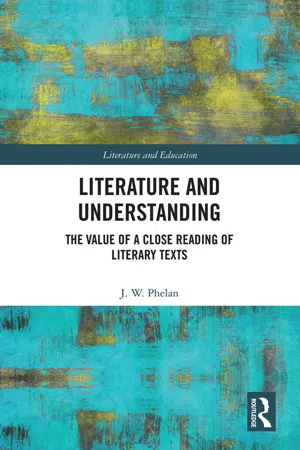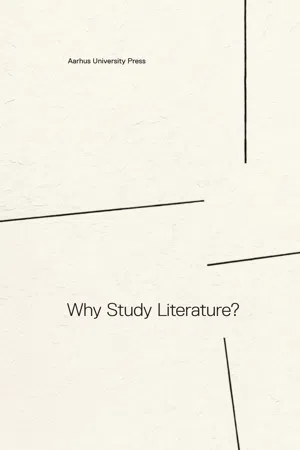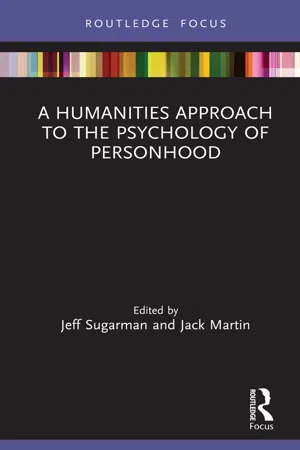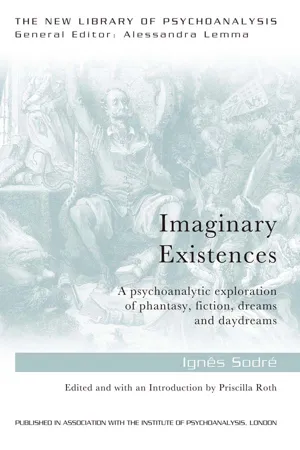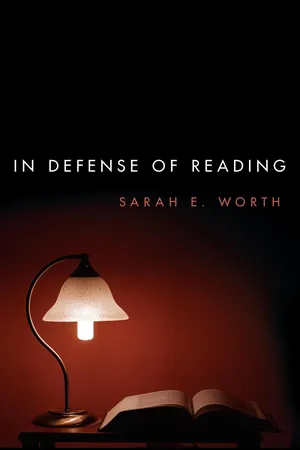Literature
Psychological Fiction
Psychological fiction delves into the inner workings of the human mind, emotions, and behavior. It often explores complex psychological themes and character development, offering insights into the human condition. This genre typically focuses on the internal struggles, motivations, and conflicts of its characters, providing a deep and thought-provoking reading experience.
Written by Perlego with AI-assistance
Related key terms
1 of 5
5 Key excerpts on "Psychological Fiction"
- eBook - ePub
Literature and Understanding
The Value of a Close Reading of Literary Texts
- Jon Phelan(Author)
- 2020(Publication Date)
- Taylor & Francis(Publisher)
Literary fiction as a subgenre of both literature and fictionThere is a tendency in the philosophy of literature, less conspicuous in the philosophy of fiction, to use the terms ‘literature’ and ‘fiction’ interchangeably. Yet the terms appear to track an important distinction; one recognised by publishers, librarians, booksellers and any reader who expects a different kind of read from the shelf marked ‘literature’ than from the shelf marked ‘fiction’.1 The problem is that in running the concepts ‘literature’ and ‘fiction’ together, no distinction is drawn between arguments that are sound only if the concept ‘literature’ is employed and arguments that are sound only if the concept ‘fiction’ is employed. As a result, the conclusions of such arguments are taken to apply indiscriminately to both literature and fiction, to the potential detriment of both. Some work needs to be done in order to determine what the conceptual relations are between literature, fiction and literary fiction. Once this is in place I can investigate the claim that the cognitive gain from reading literary fiction is generated from a reader’s engagement with literary fiction qua literature and not, as is too often assumed, qua fiction.There is a tradition that takes all literature to be fictional by definition. This view is summarised by Tzvetan Todorov when he says that literature is ‘imitation through language’ and as all imitation is not real but fictional then ‘literature is fiction’ (Todorov 1973: 7 italics in original). It is not clear, however, why we should join this tradition given that many works read and admired as literature are not fictional. Works admired for their literary qualities but which are not fictions include: Descartes’ Meditations, Gibbon’s Decline and Fall of the Roman Empire, some of George Orwell’s essays, and The Song of Solomon. Some works considered ‘literary’ include works based on fact which are fictionalised in their presentation such as Arthur Miller’s The Crucible - eBook - PDF
- Jan Alber, Kraglund, Rikke Andersen Kraglund, Stefan Iversen, Louise Brix Jacobsen, Reestorff, Camilla Møhring Reestorff, Nielsen, Henrik Skov Nielsen, Jan Alber, Kraglund, Rikke Andersen Kraglund, Stefan Iversen, Louise Brix Jacobsen, Reestorff, Camilla Møhring Reestorff, Nielsen, Henrik Skov Nielsen, Jan Alber, Rikke Andersen Kraglund, Stefan Iversen, Louise Brix Jacobsen, Camilla Mohring Reestorff, Henrik Skov Nielsen(Authors)
- 2011(Publication Date)
- Aarhus University Press(Publisher)
More specifically, my object is fiction, though I mean fictional narrative in a sense that accommodates not only the novel, but the drama (and indeed film), and a great deal of poetry too. Literary fiction, for my purposes here, is defined both etymologically (written fiction) and honorifically (fiction it is possible to credit as a significant contribution to culture, rather than just a symptomatic cultural product); at the same time, however, I situate this narrowly-defined object of study within a series of progressively more inclusive context – that is, fictions in general, narrative discourse in general, and narrative as a cognitive faculty. The recursive relationship between these contexts secures a significant continuity between literature and the broad reaches of scientific understanding, while the distinctive contribution of literary study is provided for by the re-inflection of the concept of narra-tive with each narrowing and refinement of the frame of reference. Finally, in speaking of the “force” of fictions I am proposing to make some play with the relation between the notions of “force” and “value”, extrapolating somewhat from the framework of speech act theory in order to emphasize a performative quality of literary narrative, which arises out of the recursive logic I am proposing, and which can be extrapolated one step further, to the activity of study itself. My thesis, then, is that the importance of literary fictions as objects of study can be understood to follow from the status of such fictions as the most highly elaborated instances of a mode of cognition that lies at the heart of what it is to be human (the human, I mean, as a social and trans- 236 Humanity ◀ contents cultural construct, rather than simply the species homo sapiens, though I am interested in the relation between the two). - Jeff Sugarman, Jack Martin(Authors)
- 2020(Publication Date)
- Routledge(Publisher)
3Psychology as Literature Narrative Knowing and the Project of the Psychological HumanitiesMark FreemanLife and Literature
I begin this chapter with three large questions. First, how might we understand the fact that literature—novels, memoirs and autobiographies, and certain forms of poetry—appears to be the most “natural” vehicle for exploring and understanding human lives? Second, what is the significance of the fact that literature is often able to speak to the complexities of human lives with an urgency, an intensity, and an evocative power scarcely found in psychology? Finally, what are the implications of these facts for reimagining and reconstructing the discipline?Bearing in mind these three questions, I offer a threefold thesis. The first and most basic claim to be advanced is that, in a very real sense, human life has a literary structure—which in turn suggests that narrative knowing is crucial to understanding human lives. The second claim to be advanced is that psychologists interested in understanding human lives would do well to generate literature themselves in at least a portion of what they do. For insofar as human life has a literary structure, it stands to reason that (some) psychologists ought to become writers, who seek to achieve a comparable level of urgency, intensity, and evocative power in their writing as their peers in literature. The third, and most radical, claim is that much of the discipline, in its neglect of the literary structure of human life, has been misconceived and that, consequently, entirely new ways of conceiving the discipline are called for. These new ways are rooted squarely in the arts and humanities.Before diving headlong into a more detailed rationale for these three interrelated theses, let me say a few prefatory words about each. First, regarding the idea that human life has a literary structure, there is a lot that might be said about this idea. But for present purposes, what I highlight most, following the work of Paul Ricoeur and others, is the interconnection between time and narrative (Ricoeur, 1981a, 1984, 1985, 1988, 1991a). Seen from one angle, who and what we are is the product, or the end point, of some series of experiences and events that transpired in the past. This is the broadly causal model that most of psychology tends to operate with, and it is located in chronological or “clock” time, with history—in this case, life history—being seen as precisely this irreversible chain of experiences and events. Seen from another angle, however, who and what we are is a function of what we make—and remake—of these experiences. This brings us to the second meaning of history—namely the history that is told or written, from some point in the present. Here, in other words, we are interested in what has been called narrative time (Ricoeur, 1981a). That is, we want to know how earlier experiences have been “metabolized”; we want to know the role that they have been playing in the unfolding “plot” of one’s life. From this angle, then, events and experiences are best considered as episodes- eBook - ePub
Imaginary Existences
A psychoanalytic exploration of phantasy, fiction, dreams and daydreams
- Ignes Sodre(Author)
- 2014(Publication Date)
- Routledge(Publisher)
5PSYCHOANALYSIS AND LITERATUREPsychoanalysts concern themselves at every moment in their work with listening to, thinking about, and commenting on, a particular form of narrative which is simultaneously factual and fictional; the analyst’s task of sympathetic understanding involves examining the relationship between phantasy and reality, or between, on the one hand, two forms of reality, internal and external – and on the other, the psychological distortions of true experience for the purpose of avoiding reality.The differentiation between phantasies – that is to say, fictions – that are created primarily to communicate psychological truth and those that are created to avoid truth is the basic stuff of psychoanalysis, of course: psychoanalysts deal all the time with narratives which express the rich, complicated and infinitely changeable representations of life in external and internal reality; but the analyst’s focus of attention is on the symbolic expression of what goes on in internal, psychic reality, in what we call unconscious phantasy. By this we mean both representations of the most basic ‘facts’ of human relationships, and the truthful and untruthful ‘fictions’ created around them; the reality of emotional experience, of the impact of relationships on human development, and the unconscious defences that we all use to make reality more palatable; the capacity to create conscious and unconscious phantasies is an essential factor in the working through of conscious and unconscious conflicts. The analyst’s task is to try to think differently, with the patient, about the many different stories the patient tells about the past, and about present states of mind, of relationships – the idea being that looking from different points of view, making links and observing patterns that hadn’t been seen before, will lead to greater flexibility, more mental space, greater fluidity of thought; and, most importantly, that the conscious awareness of psychic reality (of how and why our minds function from moment to moment in particular ways – of what powerful unconscious ‘plots’ inform the way we feel) will contribute to better object relations. - eBook - ePub
- Sarah E. Worth(Author)
- 2017(Publication Date)
- Rowman & Littlefield Publishers(Publisher)
The pair of opposites I want to look at is fiction and nonfiction. Although my focus will be on the ways in which we distinguish between them and whether there can be a mutually exclusive category distinction applied, the other pairs of opposites will continue to inform my investigation into the ways in which we use, understand, confuse, and misuse the tenuous distinction that we make between fiction and nonfiction. Our understanding of both genre descriptions is in fact largely dependent upon another distinction: narrative and nonnarrative, and in significant ways the negation of fiction (nonfiction) cannot fall into a mutually excluded category at all. Also, the association of truth with nonfiction and falsity with fiction is doubly wrong, since the ways in which we talk about something being true or false refers to a kind of statement of fact that a narrative description could never offer us.1. Theories of FictionIn order to understand how we understand what it means to be fictional, I want to first define what it means for a work to count as fiction and talk a bit about held theories of fiction or larger explanations about the way we understand the concept. Something fictional is created or made, not an undirected, naturally occurring event. Fictions can be made up entirely or partially, or they can be abstractions that emphasize a particular meaning or interpretation of an event. Fictions are not merely the same as lies, but they do have the connotation that they are not just stories about true events. Whereas lies are intended to undermine the truth, fictions are not. Though fictions are stories about things that have been created, imagined, speculated about, or made up, many have largely true events and/or details woven into them as well, such as historical fiction that uses historically accurate contexts to stage fictitious plots. When I read fictional stories, I need comprehensive cognitive organization to understand the linguistic elements of the narrative, but often I also have the added dimension of emotional affect that contributes to my understanding. Philosophers have questioned the authority of this emotional response because of its seeming irrationality. Why would I respond emotionally to something I know not to be the case? If I were told that I fictionally won the lottery, I would not be really excited, but I might feel something if it were told in a really good fictional story! I would not go out and run up my credit card because I do not believe that I have really won. In this case, the truth acting
Index pages curate the most relevant extracts from our library of academic textbooks. They’ve been created using an in-house natural language model (NLM), each adding context and meaning to key research topics.
